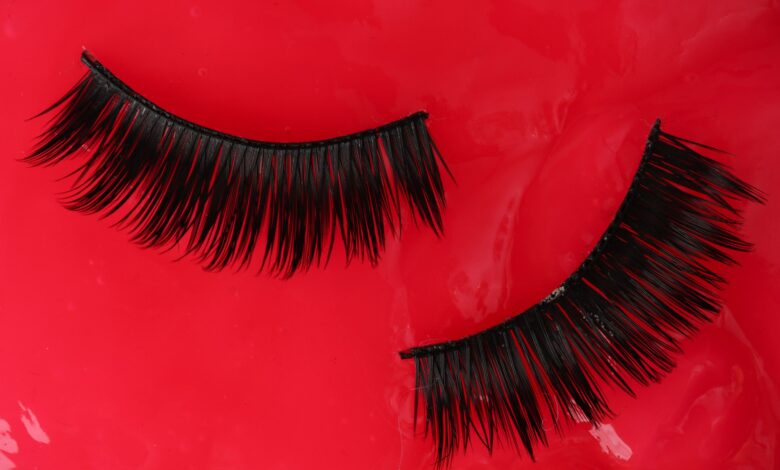Do Eyelash Extensions Cause Demodex Mites?

On this episode of American Horror Story: Beauty, I’m sorry to report that, on a microscopic level, some creepy, crawly characters are living on your face. Almost everyone has a type of mite called demodex near their hair follicles (i.e., their lashes and brows) that feed on oils, skin cells, and hormones. The vast majority of the time, you won’t even notice they’re there—these tiny critters hang out on your skin symbiotically and happily. Sometimes, though, demodex mites get a little too comfortable and cause issues—especially if you have lash extensions and don’t always keep them as clean as you should.
If demodex mites proliferate too much around the eye area, they can lead to demodicosis (face mite overgrowth) of a kind specifically known as demodex blepharitis (an inflammation of the eyelid from the face mites) and skin issues like itchiness and flaking. Those are especially common among people with eyelash extensions, since those can be magnets for buildup of the stuff these mites like to eat.
Why do these little freaks punish us for glamour, and how does it look and feel when they’re causing trouble around your eyes? Here’s what to know about these face invaders if you’re noticing some weird skin symptoms after getting your lashes done.
Mites thrive when there’s a buildup of oil or makeup around your lashes.
The reason that demodex mites flourish on some people’s skin more so than others’ is quite simple: access to food. Fake eyelashes can sometimes lead mites to come and feast because (a) people sometimes avoid cleansing their eyes to prolong the life of their extensions and (b) extra adhesive around the lash line can trap bacteria and debris.
Dendy Engelman, MD, FAAD, a board-certified dermatologist in New York City, tells SELF that a signature early sign you have too many demodex mites is “dry and irritated eyes that can feel like burning, stinging, or itching.” If the problem goes unchecked from there, you might also have symptoms like “redness, dry or rough scaly patches, or crustiness around the eyes,” she says. The crud that forms there is a byproduct of cylindrical dandruff—a waxy, scaly substance that builds up at the follicle base around individual lashes—and collarettes, a.k.a., uh, mite poop. The more mites on your face, the more crusting you’re likely to experience.
How to keep your lashes clean to avoid mite overgrowth
When you get lash extensions, your technician usually asks you to more or less raise your right hand and repeat after them: “No harsh cleansers.” But that doesn’t mean you shouldn’t use cleansers at all—quite the opposite.
In order to keep mites at bay and your lashes intact, just be selective. “Wash with a gentle, non-soap cleanser by running a Q-Tip along the lash line,” says Dr. Gohara. “Also cleanse between the eyebrows, where [Demodex mites] like to hide in the follicle.” (If you have an active infestation, she says you’ll need to repeat this twice a day, but otherwise, a daily cleanse is probably fine.)
Dr. Engelman says you also should let your lifestyle guide you. “It’s a good idea to rinse the eyelashes after a workout to avoid mite overgrowth or other eye irritations,” she says.
How to know if you’re dealing with demodex mites
Stinging and itching eyes are common problems that can be caused by a host of different things—particularly with spring allergies in bloom. If you experience these symptoms and suspect something could be up, it’s probably best to see a dermatologist or an eye doctor to figure out what’s going on for sure. “A test at the derm’s office [can quickly tell you if you have face mites],” Mona Gohara, MD, a board-certified dermatologist and associate clinical professor at Yale School of Medicine, tells SELF. “If you take a little scrape of skin and look under the microscope, you can actually see the demodex!” (Ugh.)
If you can’t make it to the doctor and you’re trying to figure things out on your own, studies indicate that the itching/burning/crusting combo could be a telltale sign of demodex overgrowth—though importantly, these symptoms can also crop up with other conditions, like conjunctivitis (pink eye). If you aren’t waking up with your lids crusted together with goop or a…pink eye, you’ve probably got a case of demodex overgrowth, particularly if the crusting lasts for over a couple of weeks.
How should I clean my lashes if I’m dealing with mites?
Research shows that tea tree essential oil is an effective way to get rid of demodex mites. It has “natural antimicrobial properties, so it helps to fight demodex mites by causing them to migrate out of the skin and eyelashes,” explains Dr. Engelman. “Wash with a small amount of tea tree oil and water,” Dr. Engelman says. “After rinsing off the lashes, pat them dry with a clean towel to prevent the increase in mite growth.” You should use tea tree oil for two life cycles of a demodex mite, which is about six weeks.
As you tend to your lashes, you don’t want to tug or pull at them or use any products that might potentially lead to more skin irritation on an already sensitive area. Dr. Engelman says that this might mean staying away from cleansers with fragrance or wipes with ingredients that linger on the skin, both of which can potentially trigger allergies. Easy does it here, in every regard.
When to see a doctor about demodex mites
If you try a tea tree oil regimen and don’t notice marked improvement, it’s really time to head over to the doctor—a prescription solution might be in order. “For severe face mite overgrowth, a doctor may prescribe topical or oral treatments,” including the topical cream crotamiton or an antibiotic called metronidazole, which comes in either a topical or oral form, says Dr. Engelman. “For people who are immunocompromised”—which can make mite outbreaks more stubborn or intense—“or whose demodicosis does not improve with other products, a stronger oral treatment called stromectol (a.k.a. ivermectin) may be prescribed.” Your doctor might also recommend medicated eye drops.
If you’re ready for this nightmare to end, here’s the bottom line.
If you have eyelash extensions, regularly washing them can prevent demodex mites from seeing your face as a buffet and multiplying. If you still have to deal with an outbreak, you can try tea tree oil, but what would be most helpful is to head to a dermatologist or ophthalmologist. They can help you make a step-by-step plan for keeping the creepy crawlies under the microscope—and out of your life for good.
Related:

